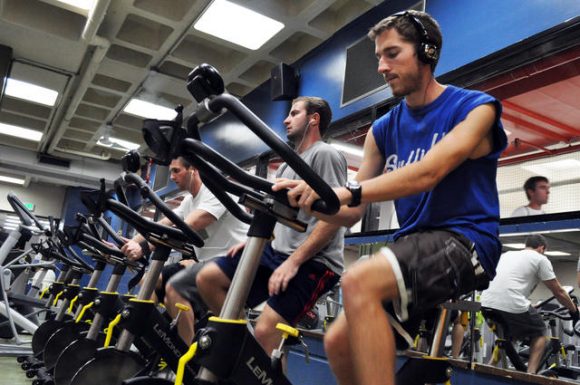
Eric Lenser, 19, a sophomore integrated physiology student (in blue) exercises at the Student Recreation Center. Every semester $84.80 of your student fees go to the Rec Center. (CU Independent/James Bradbury)
Opinions do not necessarily represent CUIndependent.com or any of its sponsors.
Think about your ideal course load. Odds are you’re thinking about a handful of major-specific advanced classes and an interesting elective or two. Fine choices, certainly, but something’s missing.
Why not Physical Education?
Students at many college campuses across the country can earn credit through physical education classes, with options ranging from standard conditioning courses to sport-specific options such as basketball and tennis. Some of the more prestigious Pac-12 campuses not only have these basic options but more niche ones as well. The University of California Berkeley offers classes in three different kinds of martial arts as well as about 10 different kinds of dance. The University of Southern California has swimming, surfing and beach soccer. Stanford University even allows students to sign up for horsemanship, sailing and Tai Chi. Shouldn’t CU do the same?
Up until 1977, Buffs had to take P.E. in order to graduate. According to USA Today, in the 1920s, 97% of colleges had a P.E. requirement. This dropped to roughly two-thirds several decades ago, and by 2010 was down to 39%. We not only lost our P.E. requirement but our opportunity to take P.E. classes for credit if we so desire.
If you think that college should predominantly focus on our mental faculties, there’s still reason to support P.E. As discussed in Inside Higher Ed, there is “copious evidence that exercise makes our brains work better” and that “exercise improves cognition.” If the goal of college is to improve our intellectual capacities, we should at least have the option to take P.E. for credit.
As anyone who sets foot on campus can tell you, there is much more to college than just the pursuit of intellectual excellence. While there are many views on the correct role of colleges and universities, all but the most callous think that it includes something along the lines of learning to be well-rounded, flourishing individuals. This can be true even if the major reason most folks enroll in college is to get a better-paying job.
Beyond improving cognition, there is scientific evidence that “suggests that exercise and physical activity are associated with better quality of life and health outcomes” in general, as well as evidence that physical activity is one of the most important predictors of well-being in college students. Even more broadly, but sadly often overlooked, physical fitness can be fun! This can take the form of playing sports or of general training. Feeling good about what you can do with your body matters. Allowing, even if not requiring, P.E. for credit would do work towards a more holistic purpose of higher education.
Although we do not have the option of taking physical education classes, there are some options for structured activity on campus (which you should certainly look into if you’re not already aware). These include intramural competition, fitness classes and instructional classes. The latter do offer some progressive instructions and courses range from six to 14 weeks. Unfortunately, as these options are seemingly relegated to the outskirts of the campus mission, many students are unaware of these options. A couple of weeks ago there was a discussion on the CU-Boulder-specific discussion forum r/cuboulder about help getting into lifting; and while folks were incredibly supportive in their responses, only one of the 33 responses even mentioned that there’s a class for that. Were P.E. courses offered for credit in addition to these other options – and I strongly endorse robust physical activity offerings on campus and in life more generally – it seems far more likely that folks would be aware that there were formal physical fitness opportunities on campus, and would be more likely to take these opportunities. Specific P.E. courses would also be able to cover significantly more ground.
Further, offering P.E. for credit would reduce the financial barrier to engage in organized physical activity. Currently, the Be Fit Pass – which gives access to fitness courses at the Rec – costs $85, and instructional classes tend to be around $50-$75 each. While tuition costs are high and rise with an increase in credit hours, the cost is capped at 12 credits. Given that most students take over 12 credits per semester, there would be no additional cost to taking P.E. courses.
Despite the benefits of a robust P.E. system, I can see why it is no longer a requirement. For one, many people have different physical capabilities and any stringent P.E. requirement could be discriminatory towards some folks. On the flip side, many are already quite active, taking advantage of the opportunities at the Rec or throughout Boulder; it would seem quite silly if CU required reigning USA 2 Mile National Champion Drew Hunter to take a P.E. class in addition to his job as a professional runner with Tinman Elite. But the mere fact that many in Boulder are already relatively active shouldn’t preclude us from having many more opportunities to be our best selves, and P.E. for credit can help with that.
By offering P.E. classes, CU would send the message that our well-being matters and is an important part of the university. If we put any value into distribution and elective requirements – and we should if we care about the whole person, not just a piece of paper – we should have the option of P.E. for credit.
Contact CU Independent Staff Writer Alex Wolf-Root at alexander.wolfroot@colorado.edu.
